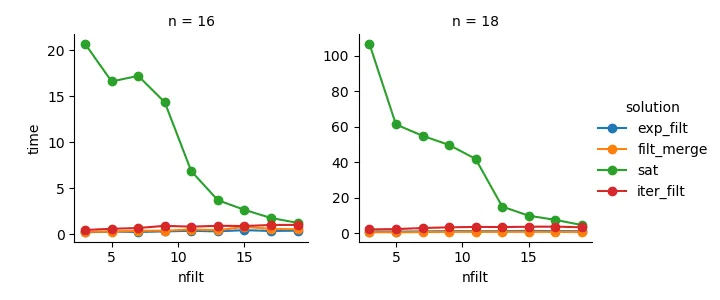问题陈述
我正在寻找一种高效的方法来生成完整的二进制笛卡尔积(包含所有True和False组合的表格,具有特定列数),并通过某些排除条件进行过滤。例如,对于三列/位 n=3,我们将得到完整的表格。
df_combs = pd.DataFrame(itertools.product(*([[True, False]] * n)))
0 1 2
0 True True True
1 True True False
2 True False True
3 True False False
...
这应该由定义互斥组合的字典来过滤,如下所示:
mutually_excl = [{0: False, 1: False, 2: True},
{0: True, 2: True}]
这里的键表示上面表格中的列。例子可以理解为:
- 如果0是False,1也是False,那么2就不能是True
- 如果0是True,那么2就不能是True
基于这些过滤条件,预期输出结果为:
0 1 2
1 True True False
3 True False False
4 False True True
5 False True False
7 False False False
在我的使用情况中,筛选后的表格比完整的笛卡尔积小几个数量级(例如,大约1000而不是2 ** 24(16777216))。
以下是我目前的三种解决方案,每种都有其优缺点,在最后进行讨论。
import random
import pandas as pd
import itertools
import wrapt
import time
import operator
import functools
def get_mutually_excl(n, nfilt): # generate random example filter
''' Example: `get_mutually_excl(9, 2)` creates a list of two filters with
maximum index `n=9` and each filter length between 2 and `int(n/3)`:
`[{1: True, 2: False}, {3: False, 2: True, 6: False}]` '''
random.seed(2)
return [{random.choice(range(n)): random.choice([True, False])
for _ in range(random.randint(2, int(n/3)))}
for _ in range(nfilt)]
@wrapt.decorator
def timediff(f, _, args, kwargs):
t = time.perf_counter()
res = f(*args)
return res, time.perf_counter() - t
解决方案1:先过滤再合并。
将每个单一的过滤条目(例如{0: True, 2: True})扩展为一个子表,其中列对应于此过滤条目中的索引([0, 2])。从这个子表中删除单个过滤行([True, True])。与完整表合并以获取过滤后组合的完整列表。
@timediff
def make_df_comb_filt_merge(n, nfilt):
mutually_excl = get_mutually_excl(n, nfilt)
# determine missing (unfiltered) columns
cols_missing = set(range(n)) - set(itertools.chain.from_iterable(mutually_excl))
# complete dataframe of unfiltered columns with column "temp" for full outer merge
df_comb = pd.DataFrame(itertools.product(*([[True, False]] * len(cols_missing))),
columns=cols_missing).assign(temp=1)
for filt in mutually_excl: # loop through individual filters
# get columns and bool values of this filters as two tuples with same order
list_col, list_bool = zip(*filt.items())
# construct dataframe
df = pd.DataFrame(itertools.product(*([[True, False]] * len(list_col))),
columns=list_col)
# filter remove a *single* row (by definition)
df = df.loc[df.apply(tuple, axis=1) != list_bool]
# determine which rows to merge on
merge_cols = list(set(df.columns) & set(df_comb.columns))
if not merge_cols:
merge_cols = ['temp']
df['temp'] = 1
# merge with full dataframe
df_comb = pd.merge(df_comb, df, on=merge_cols)
df_comb.drop('temp', axis=1, inplace=True)
df_comb = df_comb[range(n)]
df_comb = df_comb.sort_values(df_comb.columns.tolist(), ascending=False)
return df_comb.reset_index(drop=True)
解决方案2:完全展开,然后过滤
生成完整笛卡尔积的DataFrame:整个过程将在内存中完成。循环遍历过滤器并为每个过滤器创建掩码。将每个掩码应用于表格。
@timediff
def make_df_comb_exp_filt(n, nfilt):
mutually_excl = get_mutually_excl(n, nfilt)
# expand all bool combinations into dataframe
df_comb = pd.DataFrame(itertools.product(*([[True, False]] * n)),
dtype=bool)
for filt in mutually_excl:
# generate total filter mask for given excluded combination
mask = pd.Series(True, index=df_comb.index)
for col, bool_act in filt.items():
mask = mask & (df_comb[col] == bool_act)
# filter dataframe
df_comb = df_comb.loc[~mask]
return df_comb.reset_index(drop=True)
解决方案3:筛选迭代器
将完整的笛卡尔积保留为迭代器。循环遍历每一行时,检查该行是否被任何一个筛选器排除。
@timediff
def make_df_iter_filt(n, nfilt):
mutually_excl = get_mutually_excl(n, nfilt)
# switch to [[(1, 13), (True, False)], [(4, 9), (False, True)], ...]
mutually_excl_index = [list(zip(*comb.items()))
for comb in mutually_excl]
# create iterator
combs_iter = itertools.product(*([[True, False]] * n))
@functools.lru_cache(maxsize=1024, typed=True) # small benefit
def get_getter(list_):
# Used to access combs_iter row values as indexed by the filter
return operator.itemgetter(*list_)
def check_comb(comb_inp, comb_check):
return get_getter(comb_check[0])(comb_inp) == comb_check[1]
# loop through the iterator
# drop row if any of the filter matches
df_comb = pd.DataFrame([comb_inp for comb_inp in combs_iter
if not any(check_comb(comb_inp, comb_check)
for comb_check in mutually_excl_index)])
return df_comb.reset_index(drop=True)
运行示例
dict_time = dict.fromkeys(itertools.product(range(16, 23, 2), range(3, 20)))
for n, nfilt in dict_time:
dict_time[(n, nfilt)] = {'exp_filt': make_df_comb_exp_filt(n, nfilt)[1],
'filt_merge': make_df_comb_filt_merge(n, nfilt)[1],
'iter_filt': make_df_iter_filt(n, nfilt)[1]}
分析
import seaborn as sns
import matplotlib.pyplot as plt
df_time = pd.DataFrame.from_dict(dict_time, orient='index',
).rename_axis(["n", "nfilt"]
).stack().reset_index().rename(columns={'level_2': 'solution', 0: 'time'})
g = sns.FacetGrid(df_time.query('n in %s' % str([16,18,20,22])),
col="n", hue="solution", sharey=False)
g = (g.map(plt.plot, "nfilt", "time", marker="o").add_legend())
comb_iterator)运行时间差,但没有明显的内存使用。我觉得还有改进的空间,尽管不可避免的循环可能会在运行时间方面施加严格限制。
方案2: 将完整的笛卡尔积扩展为DataFrame(exp_filt)会导致内存显著增加,我希望避免这种情况。运行时间还可以接受。
方案1: 合并从各个过滤器创建的数据框(filt_merge)似乎是我的实际应用的好解决方案(请注意,随着过滤器数量的增加,运行时间减少,这是由于较小的cols_missing表所导致的)。然而,这种方法并不完全令人满意:如果单个过滤器包括所有列,则整个笛卡尔积(2**n)将最终出现在内存中,使此解决方案比comb_iterator更糟糕。
问题:还有其他想法吗?一个疯狂而聪明的numpy两行代码?迭代器方法是否可以得到改进?

